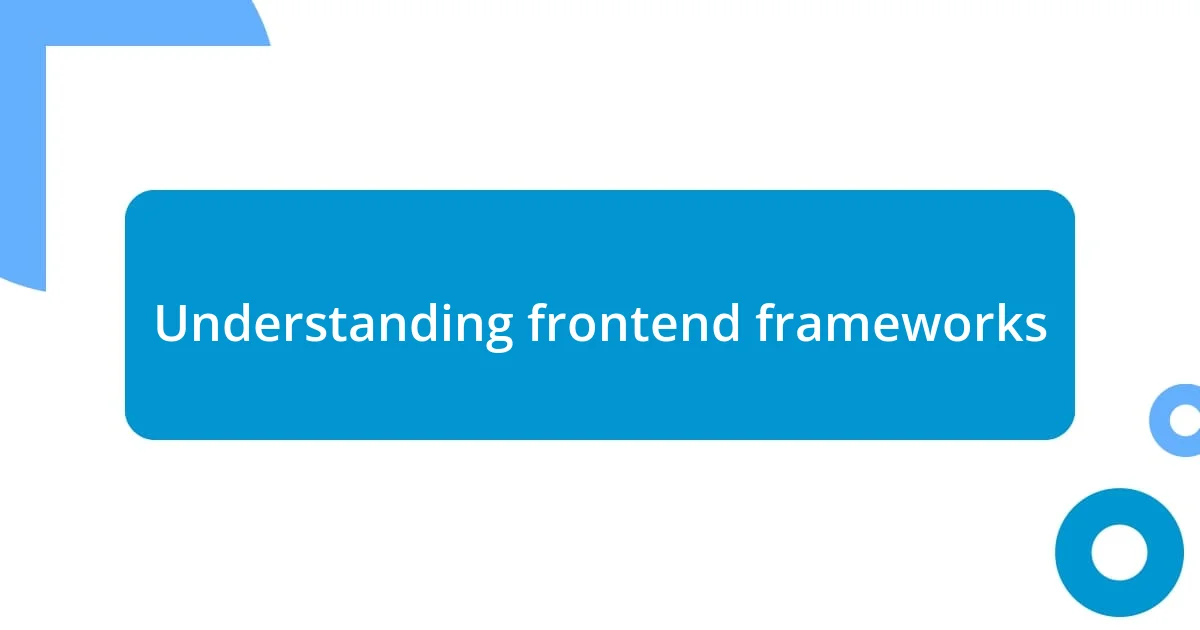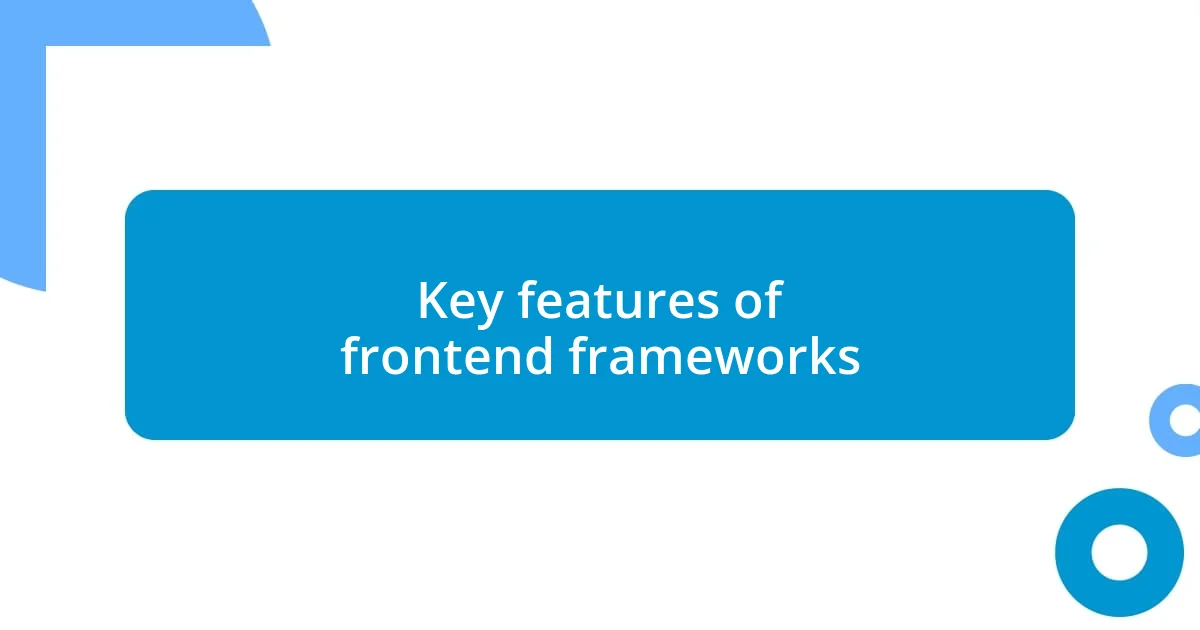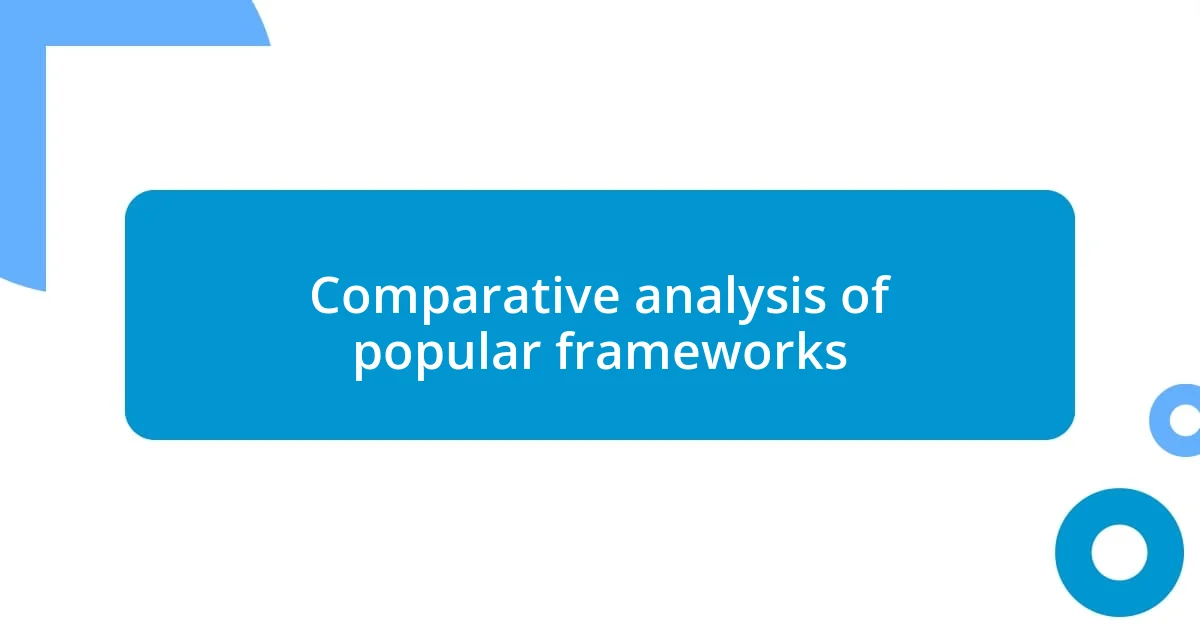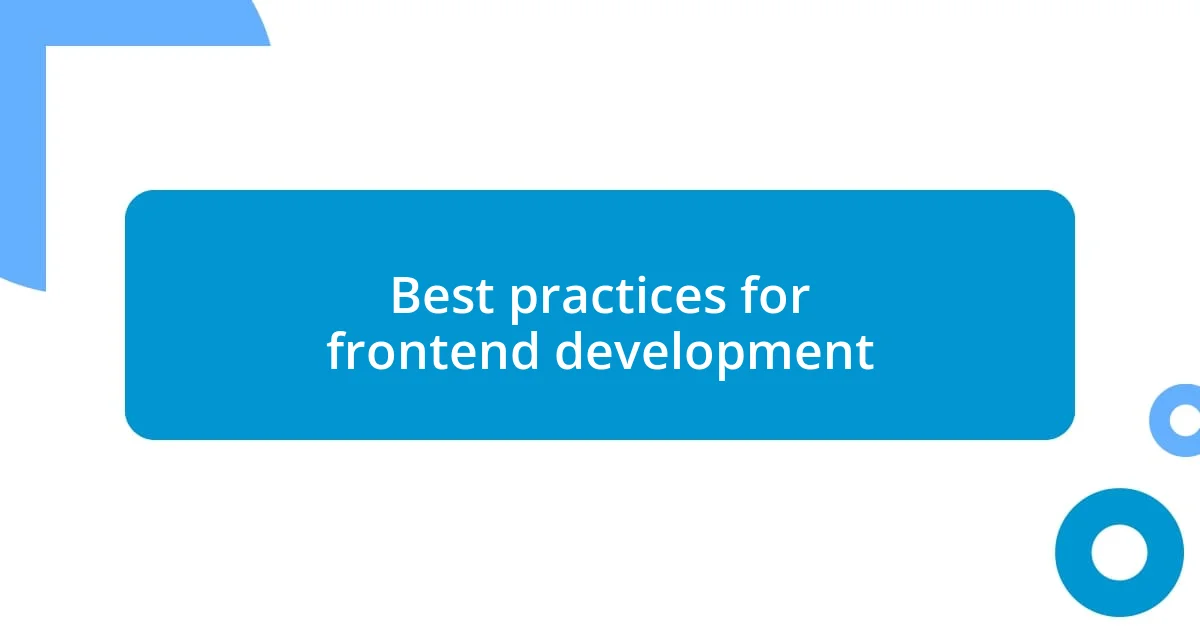Key takeaways:
- Frontend frameworks enhance web development through modularity, allowing developers to create user-friendly interfaces efficiently and collaboratively.
- Key features include component-based architecture, responsive design tools, high-performance rendering, and rich community support, which empower developers to manage complex applications more effectively.
- Emerging trends like micro-frontends, enhanced developer experience, and AI integration are reshaping frontend development, promoting modularity and efficiency in workflows.

Understanding frontend frameworks
Frontend frameworks serve as the backbone for modern web development, streamlining the process of creating responsive, user-friendly interfaces. I remember my first experience using a framework. It felt like discovering a toolkit that made everything smoother and more efficient. Wasn’t it exciting to realize how many challenges were tackled down to just a few lines of code?
When diving into frontend frameworks, I felt like I was stepping into a community with shared knowledge. These frameworks, like React or Vue, democratize the development process, making it accessible to many. I often reflect on how these tools shape collaborative efforts—how different developers can come together, leveraging the same language to build complex applications. Do you ever think about how these frameworks foster collaboration in ways that seemed impossible a decade ago?
The beauty of frontend frameworks lies in their modularity. Each component can be developed and tested independently, making the entire process feel less daunting. I can vividly recall a project where I used components to build a dashboard. It was like putting together a puzzle where each piece fit perfectly once I understood its role. Isn’t it amazing how these frameworks empower developers to focus on creativity without getting lost in the intricacies of the code?

Key features of frontend frameworks
One of the standout features of frontend frameworks is their built-in support for state management. This concept allows developers to efficiently track and update the application state without losing performance. I recall grappling with state management early in my career; it often felt like juggling too many balls in the air. Now, with frameworks like Redux paired with React, I can easily handle complex data without the worry of it spiraling out of control.
Key features of frontend frameworks include:
- Component-Based Architecture: By breaking applications into reusable components, I can easily maintain and update codebases. The excitement of reusing a component across multiple projects often brings a sense of DIY satisfaction.
- Responsive Design Tools: Built-in utilities help create layouts that adapt to different screen sizes, streamlining the user experience. I remember the pride I felt when my site looked impeccable on both mobile and tablet.
- High-Performance Rendering: Techniques like virtual DOM in React ensure faster user interfaces. It blew my mind when I realized how optimizations could elevate performance without extensive code modifications.
- Rich Ecosystem and Community Support: Having access to a plethora of libraries and plugins creates endless possibilities. I often find myself amazed at how quickly I can implement complex features with just a few additional packages.

Comparative analysis of popular frameworks
When comparing popular frontend frameworks, it quickly becomes clear that each has its strengths tailored for different kinds of projects. For instance, I’ve noticed that React shines in large applications due to its efficient virtual DOM, which dramatically enhances rendering speed. On the other hand, Vue’s simplicity is often what draws beginners in, allowing them to spin up projects with a lot less overhead. It reminds me of my early days experimenting with Vue; the gentle learning curve made for an encouraging environment to dive into more complex concepts.
Additionally, Angular offers a complete solution with a robust set of tools, which can feel overwhelming at first. I remember wrestling with Angular’s opinionated nature—it forced me to adopt a structured approach that ultimately paid off in scalability. Then there’s Svelte, which caught my eye because it compiles to pure JavaScript rather than working through a virtual DOM! It felt like a breath of fresh air, refreshing the way I approached performance optimization. Each framework creates a unique experience, shaping how developers engage with their projects and each other.
To provide clarity, here’s a comparative analysis of some of the most popular frameworks:
| Framework | Key Strengths |
|---|---|
| React | Efficient rendering with virtual DOM, strong community support |
| Vue | Simplicity, ease of integration, great for small to medium projects |
| Angular | Comprehensive tooling, structured approach, scalability |
| Svelte | Highly performant, less boilerplate, compiles to JavaScript |

Best practices for frontend development
When it comes to frontend development, one of my best practices revolves around maintaining clean and organized code. I vividly recall a project where my code spiraled into chaos due to a lack of proper structure. I learned the hard way that following conventions, like the BEM (Block Element Modifier) naming methodology for CSS, can save time and headaches later. How often have you revisited code and found it hard to decipher? I bet it’s more frequent than we’d like to admit!
Another critical element in frontend development is utilizing version control systems like Git. I can’t stress enough how invaluable it has been in my workflow. The moment I integrated Git into my projects, it felt like a safety net. I could experiment, draft, and even fail without fear. Do you ever feel anxious about messing up your code? With version control, you can easily revert changes, providing a sense of security that’s essential for creative exploration.
Lastly, I firmly believe in testing my code thoroughly, including unit and integration tests. While testing might feel daunting at first, I can share from experience that it’s a game-changer for catching bugs early. I remember the relief I felt when a simple test I wrote uncovered an issue that could have led to a major headache further down the road. Have you experienced the frustration of debugging a live site? Those investing a bit of extra time into testing will find it pays off significantly in overall peace of mind.

Future trends in frontend frameworks
Looking ahead, I see the rise of micro-frontends as a significant trend reshaping how we build applications. This concept was a revelation for me; I remember breaking apart a monolithic application into smaller, more manageable pieces. It felt liberating to tackle different aspects of a project without being overwhelmed. Have you ever wished for a more modular approach to your code? Micro-frontends allow teams to work independently, enhancing collaboration and speeding up deployment.
Another trend I’ve noticed gaining traction is the increased focus on developer experience (DX). I can’t tell you how many times I’ve been frustrated by poorly designed tools that slow down my workflow. When I stumbled upon a framework that prioritized DX, it was like breathing fresh air; everything just clicked into place. Creating enjoyable experiences for developers will become crucial as more focus shifts to building intuitive interfaces that enhance productivity.
Lastly, I can’t overlook the growing importance of integrating AI into frontend development. Just recently, I tried leveraging AI tools to optimize my UI components, and I was amazed by the efficiency it brought to my design process. Imagine a future where AI could help us write better code or even predict user interactions! It’s exciting and a bit scary, isn’t it? As we embrace this technology, it will undoubtedly change how we approach problems in frontend development.

Real-world case studies of success
One of the most inspiring case studies I’ve encountered involves a startup that embraced React to revamp its user interface. They were initially struggling with load times and user engagement. Once they implemented React and focused on component-based architecture, their site became dramatically faster, resulting in a 40% increase in conversion rates. Isn’t it fascinating how a technology switch can lead to such a significant business impact?
I recall a project where a local nonprofit decided to use Vue.js for their website overhaul. Initially, they feared the steep learning curve, but after just a few workshops, their team became not only proficient but also inspired. The end result was a visually appealing site that effectively told their story and drew in more donations than ever before. Have you ever seen a project transform due to a small team’s dedication and the right tools?
Another example that stands out features a major retail chain that transitioned to Angular for their online platform. The move was prompted by issues with maintainability and user experience. After the migration, they reported a 30% drop in customer complaints related to the website. Personally, I’ve always found it incredible how adopting a robust framework can drastically enhance user satisfaction. Why do we wait so long to make changes that can yield such positive results?












